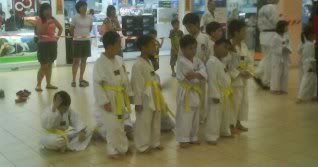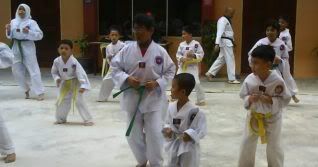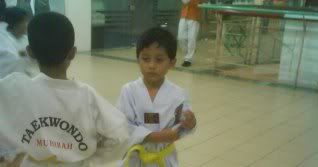A to Z of Taekwondo
A.... is for Attentive. Taekwondo kids are very attentive. For them to learn complicated taekwondo kicks and moves. They must concentrate hard. By being attentive and focus, their attention span gets longer. And longer.
Taekwondo Kid : Little Masters
Children who are in tune with their bodies and who are comfortable with their physicality are generally more confident and self-assured than other children. The discipline and respect inherent in Taekwondo prevents this confidence from developing into unchecked arrogance and aggression.
Taekwondo Kicks - Is Relaxation The Key To Your Kicking Success?
Have you ever watched top taekwondo players kick? I always notice how relaxed they are. Their shoulders are down and back. Their arms are loose. And their legs seem to work totally independently of their bodies.
A Guide To Taekwondo Belt Colors
The belts and their colors that are used with Taekwondo aren't just a random assortment of colors that are used to separate the ranks in the martial art. In Taekwondo, each belt color has a meaning that lets fighters known about their advancement
Sparring Drills Are A Vital Part Of The Learning Experience In Taekwondo
My favorite sparring drills were working on powering my kicks, and working on my speed. These techniques are vital in Taekwondo. You must have power and speed to succeed. My instructor had also given me a few combinations to practice regularly with my sparring partner and alone.
Taekwondo Kicks - Is Relaxation the Key to Your Kicking Success?
Can you relax in taekwondo when you first start out?
 Image via Wikipedia
Image via WikipediaOf course it's very hard for beginners to not tense up. The last thing you feel as a martial arts white belt is relaxed! Everything is new. The techniques are tough and alien to you. And chances are you aren't totally strong, coordinated and flexible at this stage. So of course you feel tense!
*And what does tension do to your taekwondo kicks?
If you are tense in your taekwondo class your body produces more adrenaline. This is your fight-flight hormone. It is useful if you are in physical danger. But in class it just burns your muscle energy. And you are left drained and tired. You kicks get slow and heavy.
Tension also makes your muscles stiff. And stiff muscles can't work properly. You move more like a robot than a person. Your techniques can't flow properly. Your kicks get slow and weak. And you're more prone to injuries.
*But then over time your taekwondo kicking technique improves.
As you move up through the belt system... You practice your kicking technique and get stronger and more balanced. Your body starts to remember what to do and taekwondo is more automatic. Your co-ordination improves. You get stronger and more flexible. And all of a sudden you start to feel a bit better.
*Now's the time to work on relaxing
So now your technique is good... you need to start to learn to trust it. After all taekwondo kicks work if the technique is right. And your kicks will work if you let them flow. So find ways to make yourself relax in Dojang. Drop your shoulders when they feel tense. Breathe and shake your legs if you get nervous. Step back and smile if you feel like powering a kick into the bag.
If you are not used to relaxing it takes work. You have to keep reminding yourself it's OK to let go. But once you start to trust your taekwondo kicks your results will be fantastic!
We are a family of taekwondo students. We've trained in Australia, UK and Korea. For more help with any aspect of your taekwondo kicks head to Taekwondo Kicks. We also cover tkd fitness, history, basics, patterns, self-defense, sparring, and stretching. Our site includes great photos and video footage.
For taekwondo strength and fitness ideas head here: Peak Performance Taekwondo.
Article Source: EzineArticles.com
Taekwondo - A General Background
 Image by familymwr via FlickrTaekwondo is derived from several martial arts with the main influence being tae-kyon - Korean kick fighting. "Tae" means to kick. "Kwon" means to strike using the hand, in most cases the fist. "Do" refers to the way of the art, like in the examples of Hapkido, Karate-do, Ninjado etc. Thus, the foundation of the art is the use of the hands and feet to overcome an attacker swiftly.
Image by familymwr via FlickrTaekwondo is derived from several martial arts with the main influence being tae-kyon - Korean kick fighting. "Tae" means to kick. "Kwon" means to strike using the hand, in most cases the fist. "Do" refers to the way of the art, like in the examples of Hapkido, Karate-do, Ninjado etc. Thus, the foundation of the art is the use of the hands and feet to overcome an attacker swiftly.History:
Taekwondo was originally developed in Korea in the 1950s, when a group of leading martial arts exponents came together to unify their respective disciplines under a single fighting system. The inauguration took place in South Korea on April 11, 1955, with Major-General Choi Hong Hi, a 9th dan black belt, being credited as the founder. However, its roots date back nearly 2000 years ago when it was born from an art known as hwarang do, meaning "the way of the flowering manhood".
The hwarang were young noblemen, influenced by Confucian teachings, who formed a patriotic society during the unification of Korea, in the Silla dynasty, around 600AD. The Silla kingdom was the smallest of 3 within the Korean peninsula and was constantly under attack from its two stronger neighbours. It was these constant invasions that led the Silla nobility to develop a fighting system to protect their kingdom.
Towards the end of the 10th century, following the unification of Korea, learning Taekwondo became compulsory for all young men. However, in about the 16th century, the military traditions of the country fell out of general favour and the practice of Taekwondo was kept alive only by Buddhist monks. Following the Japanese occupation in 1909, the suppression of any form of martial art only served to further its decline. The few remaining dedicated practitioners emigrated to China and Japan and hence, the art survived.
Following liberation in 1945, many Korean exiles returned to their homeland and reintroduced an improved version of Taekwondo. The Korean government, as part of its canpaign to reassert national identity after years of Japanese occupation, supported the practice of Taekwondo by officially sponsoring it. This led to a more formal approach to the teaching and grading of the discipline.
Taekwondo spread worldwide from Korea in the 1960s and the first world Taekwondo championship took place in Seoul, South Korea, in 1973. Since 1988, Taekwondo has been listed as an Olympic sport.
Competitive fighting:
Competitive fighting in Taekwondo is purely optional. For those who participate, competitions are split into 3 sections - sparring, patterns and destruction.
Sparring involves 2 practitioners practising fighting techniques to develop their timing, focus and speed. It is performed in a controlled environment so that no unnecessary injuries occur. In competition, the aim is to score points through the delivery of correct techniques to target areas.
Patterns are a set of series of combination techniques performed in a sequential order against an imaginery opponent. This is similar to Karate, which refers to patterns as kata, or Kung fu, which uses set movements called forms.
Destruction refers to breaking techniques in which practitioners learn to break, for an example, a piece of wood about 0.5 to 1 cm thick. The aim is to ensure that the power and skill of the technique are truly effective. It is also designed to focus the mind.
Thanaseelan, click on http://www.worthofwordplay.blogspot.com to view his main blog. Don't forget to check out the categories on his blog.
Article Source: EzineArticles.com
Taekwondo Kid : Little Masters
Physically, Taekwondo can play a key role in the development of motor control and coordination. It helps children to become comfortable in their bodies, and they learn of their limitations and how far they can push themselves physically. Children who are in tune with their bodies and who are comfortable with their physicality are generally more confident and self-assured than other children. The discipline and respect inherent in Taekwondo prevents this confidence from developing into unchecked arrogance and aggression.
Studies have proven that the focus children acquire from Taekwondo helps them perform better academically. They are able to block out distractions and attend to the task at hand. Discipline in the dojo also spills over into school and home, which means that children who practice Taekwondo realise their responsibilities and obligations, and are self-motivated to fulfil them. The physical exercise also increases the flow of oxygen to the brain, promoting concentration and clear thinking.
 Image by Taekwondo Kid
Image by Taekwondo KidAdvancement in Taekwondo doesn't come easily. Mastering new moves requires lots of hard work, but the satisfaction of finally getting them right proves to children that hard work pays off. Once learned, this lesson can be applied to everything in life. Children grow up believing that they can achieve anything that they put their minds to, and that challenges are mere stepping stones to success, rather than insurmountable obstacles.
Taekwondo is also a good way for children to learn that respect is earned rather than demanded, and that to earn respect is better than to create fear. Children are not only taught to respect others, but are given the opportunity to earn respect in turn. Perseverance in the face of adversity, and consideration for all others regardless of rank, gains children the respect of their peers, as well as their instructors. Through this they learn the worth of integrity and self-respect, which are qualities that are rarely regained once they are lost.
One of the uncompromising principles of Taekwondo is that the skills gained are not to be used in anger or for self-promotion, but rather to promote peace and protect others. Once children understand this and incorporate it into their lives, they are well on the way to becoming well balanced, fully functioning adults, and goodness knows the world has a dire need for more people like that.
Recommended sites:
http://www.blacktaekwondo.com.au/taekwondo/children.html
Sandra wrote this article for the online marketers Ravenscroft taekwondo and martial arts one of the leading sites for information on developments and events in Taekwondo around the world.
Article Source: http://EzineArticles.com/?expert=Sandy_Cosser











